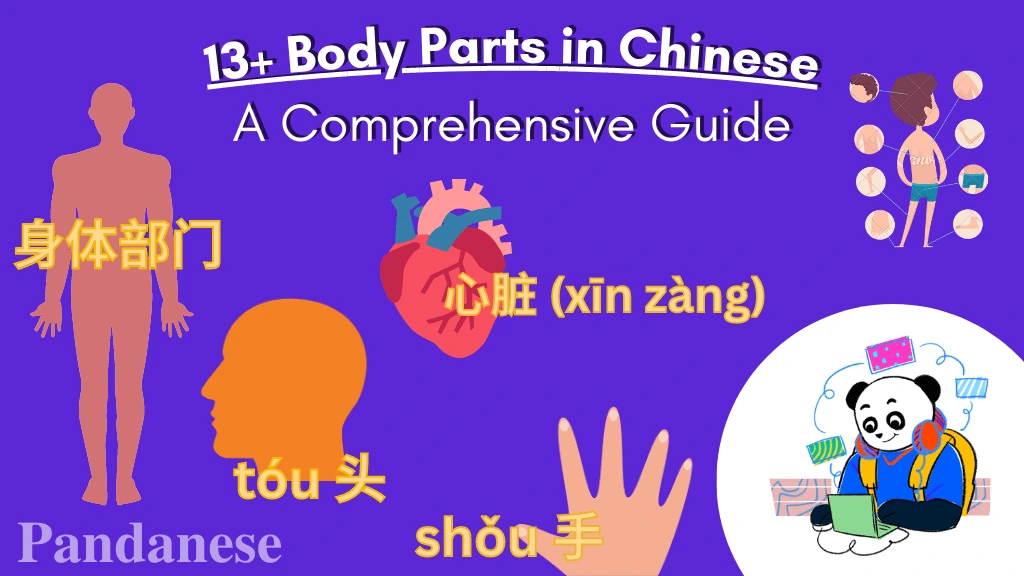
An Easy Guide to 13+ Body Parts in Chinese
Ever found yourself in a situation where you needed to describe a body part in Chinese but didn't know how to word it?
Learning the names of different body parts in Chinese is super important, whether for everyday conversations or for describing medical issues.
This article will explore the human body and its different parts in Mandarin Chinese, covering everything from the common body parts like the head, eyes, ears, and mouth to the more complex internal organs.
By the end, you'll have a comprehensive understanding of Chinese body parts and be able to communicate confidently with native speakers!
Why learn body parts in Chinese?
One of the most fundamental aspects of any language is vocabulary, and a good place to start is with common body parts.
In Chinese, body parts are referred to as "shēnti bùmén" (身体部门). It's essential to understand the correct terminology when it comes to identifying different parts of the body in Chinese.
Knowing body parts in Chinese is about more than just learning the names of different body parts. It's also about understanding the body part in language, which is vital to effective communication.
Suppose you're in a situation where a part of your body is in pain. In that case, it's important to effectively communicate which body part and describe the pain to the doctor to get a diagnosis. Additionally, you'll understand what the doctor is saying and how to get treatment for your pain.
Understanding the basics of body parts in Chinese
Learning a new language can be a challenging task, but it becomes much easier when we break it down into smaller components. One of the fundamental aspects of any language is its vocabulary, and of course, in this case, we are specifically focusing on body parts in Chinese.
In Chinese, body parts are referred to as "shēnti bùmén" (身体部门). It's essential to understand the correct terminology when it comes to identifying different parts of the body in Chinese.
Here is a comprehensive list of the most commonly used words for body parts in Chinese. We'll go through each body part, and the Chinese words used to describe them.
Parts of the face in Chinese
Head (tóu 头)
Starting at the top is the head. In Chinese culture, the head is considered one of the most important body parts as it is believed to be the location and focus of the soul.
The Chinese character for "head" is "头" (tóu).

Head body parts in Chinese
Some useful phrases related to the head in Chinese include:
头发 (tóu fà) - hair
脑袋 (nǎo dài) - brain
眉毛 (méi máo) - eyebrow
眼睛 (yǎn jīng) - eye
鼻子 (bí zi) - nose
嘴巴 (zuǐ ba) - mouth
牙齿 (yá chǐ) - teeth
Neck (jǐng zhuī 颈椎)
Below the head is the neck.

Neck body parts in Chinese
In Chinese, anything related to the neck is "颈椎" (jǐng zhuī), which means cervical vertebrae.
Here are some useful words and phrases related to the neck in Chinese include:
脖子 (bó zi) - neck
颈椎病 (jǐng zhuī) bìng) - cervical spondylosis
颈椎拉伤 (jǐng zhuīlā shāng) - neck sprain
颈椎疼痛 (jǐng zhuī) téng tòng) - neck pain
Upper body parts in Chinese
Chest (xiōng bù 胸部)
Next is the chest, which is between the neck and the abdomen. In Chinese, it is called "胸部" (xiōng bù).

Chest body parts in Chinese
Some useful phrases related to this body part include:
胸肌 (xiōng jī) - chest muscles
乳房 (rǔ fáng) - breast
心脏 (xīn zàng) - heart
肺 (fèi) - lung
Back (bèi 背部)
Behind the chest is the back, called "背部" (bèi) in Chinese.

Back body parts in Chinese
Here are some useful words and phrases related to the back include:
脊柱 (jǐ zhù) - spine
腰 (yāo) - waist
肩膀 (jiān bǎng) - shoulder
Arm (shǒu bì 手臂)
Next is the arms, called "手臂" (shǒu bì) in Chinese.

Arm body parts in Chinese
Here are some useful words and phrases related to the arms include:
手肘 (shǒu zhǒu) - elbow
手腕 (shǒu wàn) - wrist
指甲 (zhǐ jia) - fingernail
手指 (shǒu zhǐ) - finger
臂力 (bì lì) - arm strength
胳膊肘 (gē bo zhǒu) - elbow(s)
Hands (shǒu 手)
The hands are the extremities of the arms that are used for gripping and manipulating objects.
In Chinese, the hands are called "手" (shǒu).

Hand body parts in Chinese
Some useful words and phrases related to the hands include:
掌心 (zhǎng xīn) - palm
拇指 (mǔ zhǐ) - thumb
食指 (shí zhǐ) - index finger
中指 (zhōng zhǐ) - middle finger
无名指 (wú míng zhǐ) - ring finger
小指 (xiǎo zhǐ) - pinky finger
Lower body parts in Chinese

Lower body parts in Chinese
Leg (tuǐ 腿)
The legs are the body's lower limbs that extend from the hips to the feet. In Chinese, they are called "腿" (tuǐ).
Some useful words and phrases related to the legs include:
大腿 (dà tuǐ) - thigh
小腿 (xiǎo tuǐ) - calf
膝盖 (xī gài) - knee
Feet (jiǎo 脚)
The feet are used for standing and walking. In Chinese, the feet are called "脚" (jiǎo).
Here are some related words and phrases to the feet:
趾间真菌 (zhǐ jiān zhēn jūn) - athlete's foot
脚踝 (jiǎo huái) - ankle
足底 (zú dǐ) - sole
脚趾 (jiǎo zhǐ) - toe
踝关节 (huái guān jié) - ankle joint
跑鞋 (pǎo xié) - running shoes
Internal organs in Chinese
The human body has several internal organs that are essential for maintaining life. In Chinese, internal organs are called "内部器官" (nèibù qìguān). Here are some of the most important internal organs and their corresponding names in Chinese:
Heart (xīn 心)
The heart is a muscular organ that pumps blood throughout the body. In Chinese, the heart is called "心" (xīn).
Here are some related words and phrases for the heart:
心脏病 (xīn zàng bìng) - heart disease
心率 (xīn lǜ) - heart rate
心绞痛 (xīn jiǎo tòng) - angina
Lungs (fèi 肺)
The lungs are two spongy organs in the chest responsible for breathing. In Chinese, the lungs are called "肺" (fèi).
Some useful words and phrases related to the lungs include:
呼吸 (hū xī) - breathing
气管 (qì guǎn) - trachea
肺癌 (fèi ái) - lung cancer
Liver (gān 肝)
The liver is a large organ in the abdomen that performs several vital functions, including filtering toxins from the blood. In Chinese, the liver is called "肝" (gān).
Some useful phrases related to the liver include:
肝炎 (gān yán) - hepatitis
肝硬化 (gān yìng huà) - cirrhosis
Stomach (wèi 胃)
The stomach is a muscular sac in the abdomen that breaks down food. It is called "胃" (wèi ) in Chinese.
Some useful words related to this organ include:
胃炎 (wèi yán) - gastritis
消化不良 (xiāo huà bù liáng) - indigestion
胃癌 (wèi ái) - stomach cancer
Intestines (cháng fù 肠腑)
The intestines are a long tube-like structure in the abdomen responsible for digesting food and absorbing nutrients. In Chinese, the intestines are called "肠腑" (cháng fù).
Some useful phrases related to the intestines include:
大肠 (dà cháng) - Large intestine
腹泻 (fù xiè) - diarrhea
便秘 (biàn mì) - constipation
肠癌 (cháng ái) - colon cancer
Different ways to memorize the body parts in Chinese
Youtube videos and songs
There are plenty of youtube videos to help you memorize the different body parts in Chinese.
One popular way to similar to the song “Head, shoulder, knees toes” but in Chinese:
Head and Shoulders (头和肩膀) in Chinese| Sing-AlongsThere are also other videos that goes more indepth on the body parts vocabulary in Chinese:
HEAD to TOE and other common parts of the body in Chinese, ShuoshuoChinese说说中文Mnemonics
Mnemonics is a way to help you remember and recall information. It can involve anything from songs to acronyms and storytelling.
Creating your own mnemonic can be difficult, which is why Pandanese offers story mnemonics to help you learn and memorize Chinese characters. Additionally, Pandanese offers spaced repetition flashcards to help you recall, learn and review in set intervals to build Chinese vocabulary.
So, if you want to learn the body parts in Chinese more efficiently, try Pandanese for free online or on the Pandanese app.
3 common human body parts expressions in Chinese
Using body parts in Chinese expressions is a common and interesting way to express oneself.
As we mentioned earlier, many body parts have associated expressions in Chinese that add meaning and beauty to everyday conversations.
Now that we have established the basic vocabulary for body parts in Chinese. Let's explore how they are used in expressions.
1. 眼睛发红 (yǎn jīng fā hóng)
Literally translated as "eyes turn red." This expression is commonly used to describe someone angry or upset.
2. 心口如 (xīn kǒu rú yī)
This expression literally means "heart and mouth as one." It is used to describe someone as sincere and honest.
3. 肩负重任 (jiān fù zhòng rèn)
Translated as "carrying heavy responsibilities on the shoulders." This expression is used to describe someone who has a significant burden of responsibility.
Most definitely, some other words or phrases utilize body language in Mandarin. These words are just some examples of the fun and interesting ways they are incorporated into expressions.
In closing
Knowing these words and phrases for the body parts in Chinese is a great way to start the language and Chinese vocabulary. It's important to remember that Chinese is a tonal language, so the pitch and tone of your voice can make a big difference in the meaning of a word.
Practice saying these words out loud to get a feel for the tones.
As you continue to learn and practice Mandarin, your vocabulary will expand, and you'll become more comfortable with the language. Good luck on your language-learning journey!
Jing You is a Chinese native who grew up in the Fujian province and soaked in the Chinese culture while living with her grandparents. She later moved to Singapore to pursue further education. However, she has always been passionate about the Mandarin language despite being in an environment that speaks English predominantly. She was involved in multiple Mandarin and Chinese culture programmes in schools, and brought this passion forward by tutoring elementary school students Mandarin in her adulthood.
The easiest way to learn Chinese & build vocabulary

